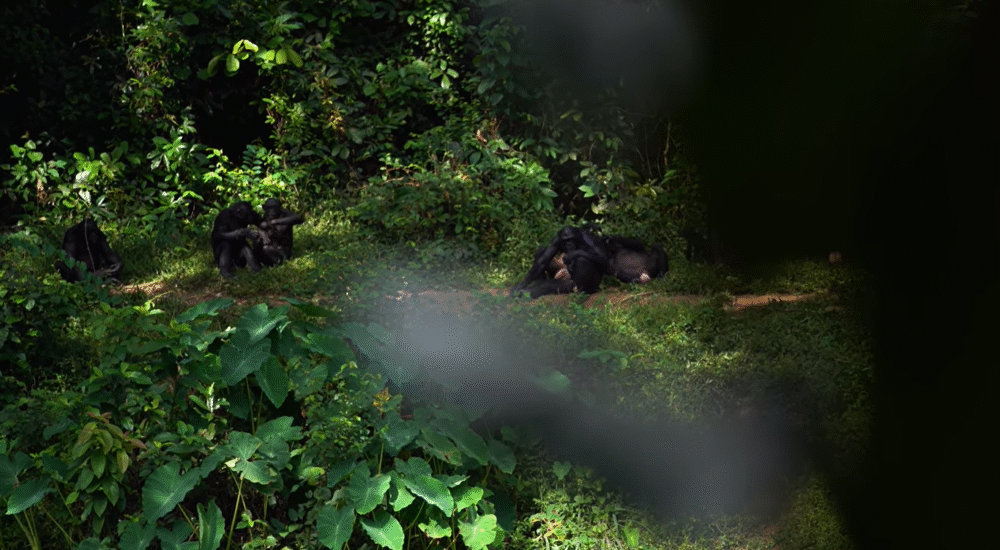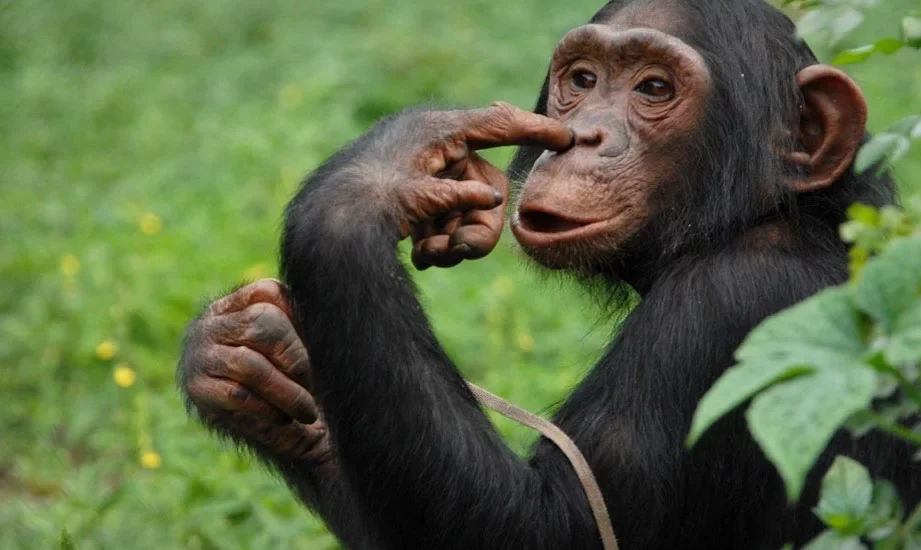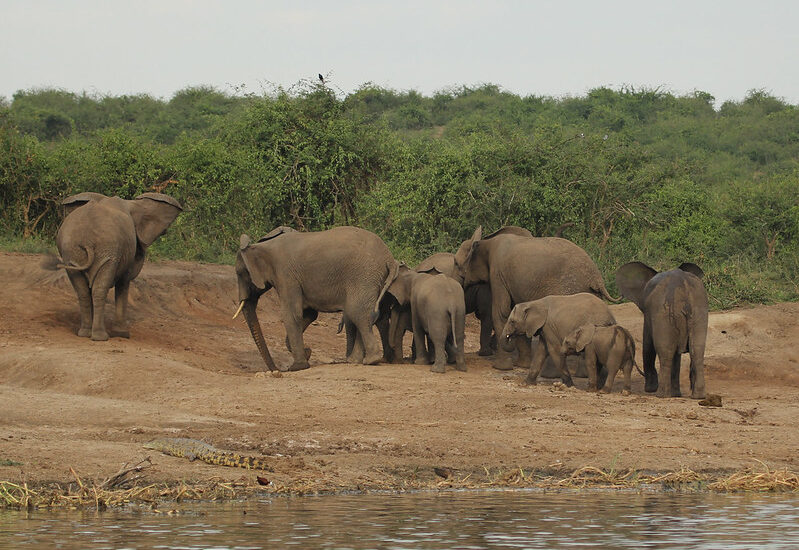Chimpanzee tracking in Kibale National Park offers one of the most immersive wildlife experiences in…
Uganda Chimpanzee Trekking Permits Costs and Prices
Uganda Chimpanzee Trekking Permits Costs and Prices, Trekking with chimpanzees in Uganda takes you to Africa’s gem for a unique experience with our closest living relative. Along with gorillas and orangutans, chimpanzees are in the same family as great apes. They have huge brains and a great ability to learn new things because they spend so much time with people. Jane Goodall and other great primatologists have found different cultures among different groups of people based on their different diets and environments.
Without a question, Uganda is one of the best places in the world to watch chimpanzees. Plus, there are over 5,600 chimps in the wild and a lot of places where you can watch them. It has one of the largest populations and most tracking opportunities. There are times when Ugandan chimpanzees are found living in small forests on private land.
Uganda has many great places to see chimps. Some of these are Kibale National Park, Murchison Falls National Park’s Budongo Forest, Queen Elizabeth National Park’s Kyambura Gorge or Kalinzu Forest, and Toro-Semliki Wildlife Reserve. You can also see chimpanzees in zoos and wildlife parks, like the Ngamba Island Chimpanzee Sanctuary and the Uganda Wildlife Education Center.
What is a permit to go trekking with chimpanzees?
A chimpanzee trekking permit is a receipt that shows payment and lets people go on a guided tour in a forest area with a group of chimpanzees that are used to people. The Uganda Wildlife Authority gives it to you after you pay the standard price. There will be your real name as it appears on your passport, the date of tracking, the location of the action, and a unique number on the Chimpanzee trekking permit.
At the tourist center, you will need to show the park warden your written permission along with your passport before you can go trekking. Chimpanzee trekking permits bring in a lot of money that is used to fund projects that protect primates, do scientific study, and protect the natural environment. The money from the permits also goes a long way toward funding long-term tourist projects that help the people who live near protected forests make a living.
How much does it cost to go hiking with chimpanzees in Uganda?
People from outside of Uganda must pay $250 for a chimpanzee trekking pass in Kibale National Park. Residents pay $200, and people from East Africa must pay UGX 180,000. The fee to go on a chimp hiking trip is $130 for each person in Budongo Forest and $100 for each person in Kyambura Gorge in Queen Elizabeth National Park.
For $300, foreign visitors can get a chimpanzee habituation permit in Kibale National Park. This permit lets tourists spend the whole day tracking wild chimpanzees with researchers. In Nyungwe Forest National Park in Rwanda, on the other hand, a chimp trekking pass costs $150 for people who are not from Rwanda, $75 for people who are from Rwanda, and $25 for people who are from East Africa.
What comes with the pass to trek with chimpanzees?
With a chimpanzee trekking permit, you can spend an hour with a group of chimpanzees while being watched. If you get permission from the chimps, you can go hiking with a group of eight to twelve people who are used to being there, two armed guards for safety, and an experienced tracker in charge of the group.
It’s like having a park ranger or helper with you on the chimp trekking trip. It will tell you what’s new in the bush, with the people who live there and the monkey. They will also let you know if there is a sudden change in the environment, like chimps becoming hostile or thieves coming in.
The chimp permit also covers the cost of entering most chimp trekking spots in Uganda. The only one that doesn’t is Nyungwe Forest National Park in Rwanda. The chimp trekking ticket also said that you could only go trekking on the day that it said on it.
The chimp trekking ticket can’t be used again or given to someone else after it has been used or the tracking date has passed. It’s important to know, though, that the Uganda chimpanzee trekking permit doesn’t cover any of the other costs that come with your trip, like lodging, transportation, and planning. The fees for chimpanzee trekking permits only cover the exercise. They don’t cover anything else.
Should you go chimpanzee trekking?
Chimpanzee trekking may not get as much attention as it should, but following our evolutionary ancestors through the Ugandan bush is one of the most exciting trips that costs a small part of what other trips do.
It is worth seeing chimps in the African jungle, where they live naturally, even though more study has been done on them than on any other primate. Uganda’s Kibale Forest National Park is one of the best places to track chimpanzees. Five settled groups live within easy walking distance of the park’s visitor center.
Where can I get a permit to hike with chimpanzees in Uganda and Rwanda?
It is only the Uganda Wildlife Authority (UWA) that can give out chimp permits in Uganda and Nyungwe National Park in Rwanda. The two groups may sell chimpanzee trekking permits directly to tourists, based on where the groups will be watching the chimpanzees.
You can also get a chimp trekking permit through a good tour operator. However, the tour operator will charge you extra for getting the permit on your behalf, but it won’t be more than the normal price of the permit.
How do I get my pass to go trekking with chimpanzees?
In Uganda, you can get a permit to go chimpanzee trekking from the Uganda Wildlife Authority by calling or emailing the reservations office in Kampala, or you can go through a reliable tour operator. If you use a tour provider, they will contact us with the date, month, and location where you want to hike with the chimps.
We will then check to see if permits are still available and get back to you. You will have to pay a deposit for the chimpanzee permit. Once you have paid, you will need to email us a picture of your passport. This information will be used to get your permission, and we will then get the permit for you.
People who want to go chimpanzee tracking in Uganda should get their permits at least three to four months before their trip, because they are in high demand and often sell out during the busy season.
When is the best time to go hiking with chimpanzees in Uganda?
Uganda has two seasons, like other tropical places: wet and dry. From April to May and October to November, it rains. From December to early March, it doesn’t rain. The dry season is the best time to go chimp trekking in the Kibale bush. During the dry season, though, the forest may get crowded because so many people go there to track chimpanzees in Kibale National Park.
If you want to see chimpanzees and other animals at the other game viewing spots, the dry season is the best time to do so. If you only want to see the chimps in Uganda, you should go during the off-season to avoid crowds. You can also expect rain all year long in Kibale because it is a jungle. Plan to go in the morning if you can, since the weather in the afternoon is hard to predict (it usually rains in the afternoon).
How fit do you need to be to go monkey climbing in Uganda?
Watching monkeys is fun even if you are not in great shape. You will need to be very strong willed to see the Kibale monkeys if you are not in good shape. Depending on the time of day and how active they are, chimpanzees will move, which will make you move too. Everyone who wants to take part will be split into groups and go to different homes. Some families stay close to where the game starts, while others stay farther away, so you have to walk a long way through the thick bush.
How safe is it to go chimpanzee hiking in Uganda?
There are no risks at all when you go chimpanzee hiking in Uganda. There are strict safety rules in place to make sure that both tourists and chimps are safe because chimp trekking and habituation experiences bring in a lot of money for Uganda. It’s safe to be in the park with chimps as long as you follow the rules set by the Uganda Wildlife Authority.
Yes, there have been some troubling times when chimpanzees attacked Ugandans and chimpanzees were killed by Ugandan families, usually because they lost crops. The monkeys were coming up to Kayamajaka town to get food. They were climbing trees and grabbing bananas and mangoes. Chimpanzees are officially protected in Uganda, which means it is against the law to hunt or kill them.
Should I hire a porter to help me when I go chimpanzee hunting in Uganda?
For about $15 USD, you can hire a helper. This porter will take your bags, go on the chimp safari with you, and help you keep your balance if you need it. You might not be sure if you need to hire a helper, but I think you should. In the end, as you walk through the bush, your bags will get heavier.
There should be a lot of water, a packed lunch, energy bars, a rain jacket, and maybe some cameras. You’ll be glad that someone is holding your bags after (often many) hours of walking. You are also helping the local community when you hire a servant, which is a great reason to do it. Most of the workers are students or locals who want to make extra cash.
When I go chimpanzee hunting in Uganda, how likely am I to see a chimpanzee?
Chimpanzees, on the other hand, live in the wild, so seeing them is almost certain. Because of this, Kibale National Park is the best place in Uganda and East Africa to go chimp hiking because the chances of seeing them are more than 95%.
People are taken by the ranger to the spot where the chimps were last seen. They keep going on their quest to find the ape family. You can change your permission for the next day if there are any open time slots if you track for a whole day and don’t see any chimps in Kibale Forest. If this isn’t possible, you might be able to get 50% of the value of the pass back.
What is the best place in Uganda to go chimpanzee trekking?
Going on a trek with chimpanzees in Kibale National Park.
There are about 120 chimpanzees that live in the park and another 1400 that live in the bush, making Kibale National Park the world’s primate capital. About 95% of the time, hiking will lead you to chimpanzees. You can go chimpanzee trekking twice a day, in the morning at 7 a.m. and in the afternoon at 12 p.m. Each day, up to six groups of six people can go hiking. The forest is home to about 13 different kinds of primates, such as baboons, red-tailed monkeys, black and white colobus, and red colobus monkeys.
People love going on the chimpanzee trek in Kibale National Park because it lets them see chimps in their native environment. It’s more than 90% likely that you will find them because Kanyanchu’s groups are used to people being around—some have been watched for more than 25 years. There are more than 1,500 chimps living in the park.
Chimpanzee walks in Kibale National Park leave from the Kanyanchu Visitor Center at 8:00, 11:00, and 14:00. The trips last from two to five hours. It is best to get there early so that you have time to sign in and get briefed. You can only spend an hour with the chimps, and your group can only have six people. You must be 16 or older to participate. You must make bookings ahead of time.
Going on a trek with chimpanzees in Kalinzu Forest.
About 300 chimpanzees live in the Kalinzu forest near Queen Elizabeth National Park. About 40 of them are used to seeing people. When you go trekking, you have a 60% chance of seeing chimps. But the bush has a lot more to offer than just chimp trekking. As you go on this chimpanzee trekking tour in Uganda, enjoy the beautiful scenery and flowing streams. This walk is usually long, so you need to be in good shape.
In Murchison Falls National Park, you can go chimpanzee trekking.
You can go chimpanzee trekking in the Budongo forest in the Kaniyo Pabidi area of Murchison Falls National Park. The bush is where most chimpanzees live, but only a few are trained to be seen by tourists. In Kaniyo Pabidi, you can tell the park staff about your chimpanzee walk the day before, but in Kibale Forest National Park, you have to get a permit ahead of time.
Trekking with chimpanzees in Queen Elizabeth National Park’s Kyambura Gorge.
The famous Kyambura Gorge in Queen Elizabeth National Park is a rare underground forest in the middle of Savannah Park. Some chimps live in the forest, but they can be hard to spot at times. The hike through the forest is fun, and the views of the canyon from a lookout are valuable. As they look for chimpanzees, they might come across hippos, elephants, or even lions very rarely.
Meeting a chimpanzee on Ngamba Island
If you don’t have much time, the Ngamba Island Chimpanzee Sanctuary is a great place to get close to Chimpanzees. It takes 45 minutes by speed boat to get to the refuge from Lake Victoria’s Entebbe port, and 1.5 hours by traditional canoe with a motor.
Other things to do after trekking chimpanzees
After an exciting day of chimpanzee climbing in Uganda, there are many other things to do that show off the country’s beautiful wildlife and rich culture. If you go to Queen Elizabeth National Park and take a boat tour on the Kazinga Channel, you might see hippos, crocodiles, elephants, and many kinds of birds along the water.
While on a game drive through the park, you can also see lions, buffalo, and leopards in the wild. To see more monkey-themed activities, you could go gorilla trekking in Bwindi Impenetrable Forest. This is a unique chance to see mountain gorillas in the wild.
To learn about Ugandan customs, music, and crafts, people who are interested in cultural experiences can go to a nearby village. You could also go to Lake Bunyonyi, a calm crater lake where you can kayak, watch birds, or just rest by the water.
Mountain hikers who like to take risks might also enjoy the Rwenzori Mountains or Mount Elgon, which have beautiful trails, waterfalls, and unique alpine scenery. Uganda has a lot of things to do besides chimpanzee hiking, so you can easily make your trip longer and have a more complete and memorable time in East Africa.


